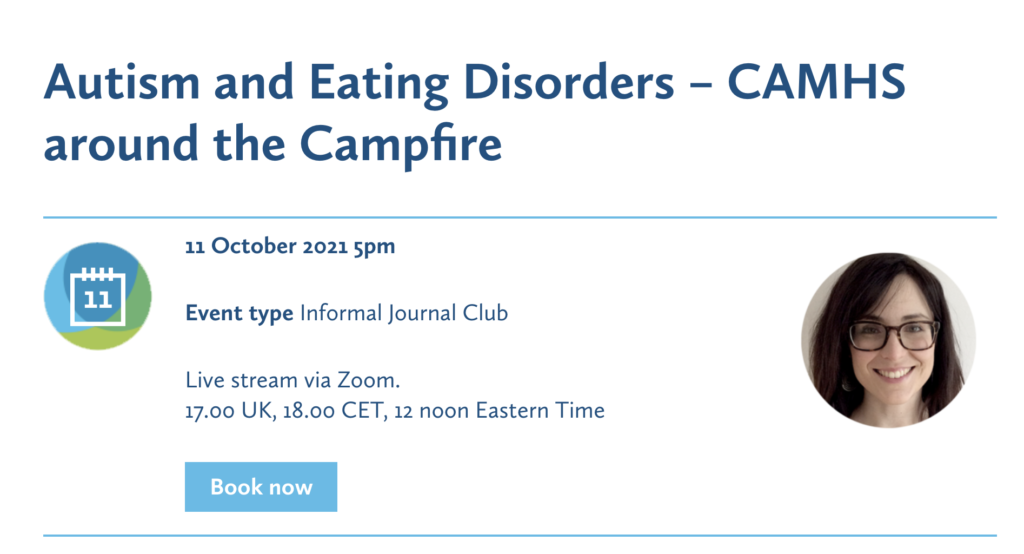
Evidence from clinical experience and previous research has shown that people with eating disorders often exhibit autistic traits. The nature of this association is not clear.
It is plausible that communication difficulties might exacerbate the mental distress that leads to disordered eating behaviour (DEB), but it is also plausible that the picture is more complicated than that. For instance, the adverse effects of inadequate nutrition and low mood in eating disorders may mimic autistic traits.
Recent research has shed light on the link between anorexia nervosa and autism, and it’s estimated that 20-30% of individuals with anorexia nervosa will also meet the diagnostic criteria for autism spectrum disorder (Westwood & Tchanturia, 2017). See our recent “One size does not fit all” blog by Shania Lorenz for a summary of a qualitatively study looking at the eating disorder service experiences of autistic women with anorexia nervosa.
This is an unusual blog in that we look at two papers exploring the relationship between autistic traits and eating disorders in young people. It would have been remiss to do otherwise. Both are prospective cohort studies, both were published around the same time in the Journal of Child Psychology and Psychiatry (JCPP), and each seems to come to a different conclusion.

Two studies looking at a similar question, but with different methods and different results.
Methods
The first paper covered in this blog, by Solmi et al (2021), used data from the ALSPAC cohort. The second paper, by Dinkler et al (2021) used data from the CATSS cohort.
I’ll summarise the methods side-by-side for ease of comparison:
|
The ALSPAC Study |
The CATSS Study |
| Longitudinal population-based cohort study, conducted in the UK from 1991 onwards. | Longitudinal population-based cohort study of twins, conducted from 2004. |
| Participants | |
| Young people with disordered eating behaviour (DEB) data at age 14, and at least one autistic trait measurement between the age of 7 and 16. | Twins with autistic trait measurements at age 9 and 18, and anorexia nervosa clinical diagnoses from health care register at age 18. |
| Exposures | |
| Autistic social traits, as measured by the Social and Communication Disorders Checklist (SCDC) at ages 7, 11, 14 and 16. | ASD, derived from Autism-Tics, ADHD and other Comorbidities inventory (A-TAC), using 12 of the 17 items, at age 9 and age 18. |
| Outcomes | |
| Any DEB as measured by self-reported postal questionnaire assessing three types of behaviour: fasting, purging, binge-eating. The responses were consolidated into a binary indicator of whether the behaviours were present or not. | Diagnosis of Anorexia Nervosa (AN), as retrieved from the Swedish National Patient Record system, or from a parent’s report of current treatment for AN. |
Results
| The ALSPAC Study | The CATSS Study |
| 5,381 participants had both Social and Communication Disorders Checklist (SCDC) and disordered eating behaviour (DEB) data measured at age 14. This was 39% of the original cohort. | 5,987 participants had Autism-Tics, ADHD and other Comorbidities inventory (A-TAC) data at both age 9 and 18. This was 36% of the original cohort. |
Participants with DEB at age 14, compared to those without DEB:
|
No association was found between ASD scores at age 9 and the risk of subsequent Anorexia Nervosa (AN).
Restrictive/repetitive behaviour and interests at age 18 were higher in girls with acute AN, but not in girls with previous AN. |

These studies suggest that there is an association between autistic traits and disordered eating behaviour, but its direction and extent remain unclear.
Strengths and limitations
| The ALSPAC Study | The CATSS Study |
| Lack of DEB data points at ages other than 14 limits the scope of the analysis somewhat.
|
ASD scores were somewhat retrofitted, using a subset of the A-TAC items, to ensure that data at age 9 was comparable to data at age 18. The researchers cross-validated this method against clinical diagnoses of ASD and found a close correspondence, suggesting the approach was valid. |
| The study did not look at specific eating disorder diagnoses. We would expect a lot of heterogeneity amongst the “DEB group”. | Age of ascertainment of an AN diagnosis varied from 17 and 24 years. |
| The DEB data was from self-reports; the SDCD data were reported by parents. | The researchers made efforts to reduce measurement bias of AN status. |
| There was also a lot of missing data, which was imputed by statistical inference. Children with missing data were more likely to have younger, less well educated mothers with a higher BMI and a history of depression. | They also explored the 53% attrition rate and concluded that those lost to follow-up did not differ significantly from those who were included in the study. |
| The researchers tested the associations in a number of different statistical models and sensitivity analyses, and found that the direction of association was consistent. | The small number of AN cases (2.4% of girls and 0.7% of boys) limited the statistical power of the study. |

On the face of it, these studies present contradictory evidence. The ALSPAC study (Solmi et al, 2021) found an association between autistic traits at age 7 and subsequent disordered eating behaviour. The CATSS study (Dinkler et al, 2021) found no association between autistic traits age 9 and subsequent diagnosis or treatment for anorexia nervosa.
Conclusions
Although there is an association between autistic traits and disordered eating behaviour, its direction and extent remain unclear.
On the face of it, these studies present contradictory evidence. ALSPAC found an association between autistic traits at age 7 and subsequent disordered eating behaviour. CATSS found no association between autistic traits age 9 and subsequent diagnosis or treatment for anorexia nervosa. This difference may be because the studies defined the outcome measures for eating disorders quite differently. ALSPAC had a much broader definition, whereas CATSS only looked at the narrow (and rarer) cases of a clinical diagnosis of AN.
Although early autistic traits may be associated with subsequent disordered eating behaviour, these behaviours don’t necessarily escalate into a clinical diagnosis of anorexia nervosa.
The studies also used different methods for measuring autistic traits. The ALSPAC study focused on the social communication aspects of autism, whereas the CATSS study included repetitive behaviours. The CATSS researchers (Dinkler et al, 2021) raise important issues concerning the validity of autistic trait measures in girls, particularly in the context of “camouflaging”.
Such problems are always going to arise where we have prospectively-gathered data set which is interrogated retrospectively. They underline the need for caution in interpreting such studies, and the need for better ways of measuring autism and autistic traits.
Clinicians should consider communication difficulties in managing young people with eating disorders. They should be mindful, of course, that diagnosing autistic traits is difficult in people who often present suffering with low mood and the substantial adverse effects of poor nutrition. The CATSS team identified “camouflaging” in cognitively able individuals as a potential explanation for low ASD scores in their study.

Clinicians should consider communication difficulties in managing young people with eating disorders. They should be mindful, of course, that diagnosing autistic traits is difficult in people who often present suffering with low mood and the substantial adverse effects of poor nutrition.
#CAMHScampfire
Join us around the campfire to discuss this paper
The elves are organising an online journal club to discuss these papers with the lead authors Dr Francesca Solmi and Dr Lisa Dinkler, someone with lived experience of eating disorders and autism, and our good friends at ACAMH (the Association of Child and Adolescent Mental Health). We will discuss the research and its implications. The webinar will be facilitated by André Tomlin (@Mental_Elf).
The focus will be on critical appraisal of the research and implications for practice. Primarily targeted at CAMHS practitioners, and researchers, ‘CAMHS around the Campfire’ will be publicly accessible, free to attend, and relevant to a wider audience.
It’s taking place at 5-6pm BST on Monday 11th October and you can sign up for free on the ACAMH website or follow the conversation at #CAMHScampfire. See you there!
Links
Primary papers
Solmi, F., Bentivegna, F., Bould, H., Mandy, W., Kothari, R., Rai, D., Skuse, D. and Lewis, G. (2021), Trajectories of autistic social traits in childhood and adolescence and disordered eating behaviours at age 14 years: A UK general population cohort study. J. Child Psychol. Psychiatr., 62: 75-85. https://doi.org/10.1111/jcpp.13255
Dinkler, L., Taylor, M.J., Råstam, M., Hadjikhani, N., Bulik, C.M., Lichtenstein, P., Gillberg, C. and Lundström, S. (2021), Anorexia nervosa and autism: a prospective twin cohort study. J Child Psychol Psychiatr, 62: 316-326. https://doi.org/10.1111/jcpp.13265
Other references
Westwood, H. & Tchanturia, K. (2017). Autism spectrum disorder in anorexia nervosa: An updated literature review. Current Psychiatry Reports,19, 1-10. Doi: 10.1007/s11920-017-0791-9
One size doesn’t fit all: new insights into eating disorders and autism
The ALSPAC Study home page, University of Bristol, accessed 30/9/21.
The CATSS Study home page, Karolinska Institutet, accessed 7/10/21
#CAMHSCampfire event page on the ACAMH website.

